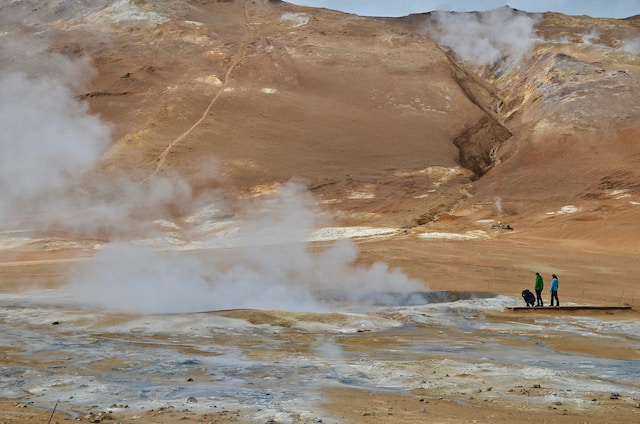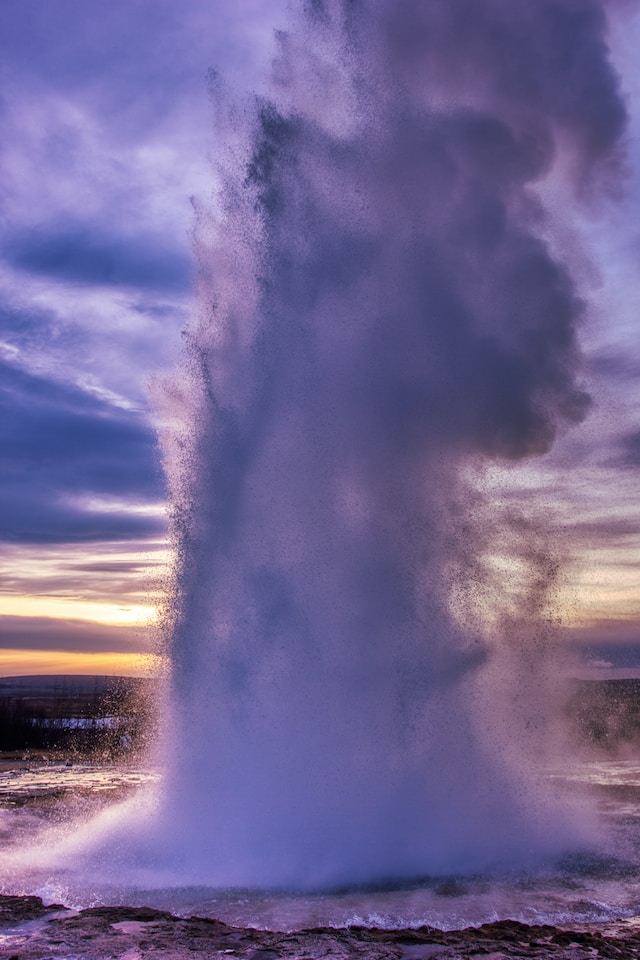
The earth beneath our feet is a vast source of energy. Its intense heat can be harnessed through geothermal energy to power homes, businesses, and even entire cities. Geothermal energy is a sustainable and reliable source of power that has the potential to revolutionize the way we consume energy.
At its core, geothermal energy is based on the fact that the temperature of the earth increases as you go deeper into its surface. This means that there is a huge amount of thermal energy stored in the earth that can be tapped into for electricity generation or heating purposes. The most commonly used method involves drilling deep wells and using steam or hot water obtained from the earth’s rock layers to power turbines, which generate electricity or heat.
Benefits of Geothermal Energy
Geothermal energy has several advantages over conventional forms of energy. It is a renewable source of energy, as the earth’s heat is constantly replenished. This means that geothermal energy has virtually no carbon footprint and is environmentally friendly. Geothermal power plants are highly efficient and can operate round the clock, unlike solar or wind-powered plants, which are reliant on weather conditions.
Another benefit of geothermal energy is that it can be utilized for a wide range of purposes. From heating homes and greenhouses to powering industrial processes, geothermal energy can meet a broad range of energy demands. Its applications are not limited by geography either, as geothermal resources are found in virtually every region of the world.
In the future, geothermal energy is set to play a critical role in reducing our dependence on fossil fuels and combating climate change. It has the potential to contribute significantly to the global energy mix and could help reduce greenhouse gas emissions by providing a cleaner and more sustainable source of energy.
As we look to build a more sustainable future, geothermal energy will undoubtedly be an essential part of the renewable energy mix. Its benefits are clear, and as technology continues to advance, we can expect to see more widespread adoption of this ancient source of energy in the years to come.
Geothermal Energy Sources
Geothermal energy sources refer to the locations where heat from the earth’s core can be accessed and utilized for various purposes. These sources are distributed worldwide, providing a reliable and renewable source of energy. In this section, we will explore the different types of geothermal energy sources and their characteristics.
Volcanic Areas
Geothermal Hotspots
- Volcanic regions, such as the Ring of Fire, are well-known for their geothermal hotspots.
- These areas have intense geological activity due to the movement of tectonic plates, resulting in underground reservoirs of hot water and steam.
- Geothermal power plants in these locations harness the high temperatures and utilize the steam for electricity generation.
Geysers and Hot Springs
- Geysers and hot springs are natural manifestations of geothermal energy sources.
- These occur when groundwater seeps deep into the Earth’s crust, is heated by geothermal energy, and rises back to the surface.
- Geysers, like the famous Old Faithful in Yellowstone National Park, eject hot water and steam periodically, while hot springs offer warm or hot water pools.

Geothermal Wells
Enhanced Geothermal Systems (EGS)
- Geothermal wells can be drilled almost anywhere in the world, even in regions without volcanic activity.
- Enhanced Geothermal Systems (EGS) technology involves drilling deep into the Earth’s crust and creating fractures in hot rock formations.
- This process enables the circulation of water or other fluids to extract heat from the rocks and generate geothermal power.
Geothermal Heat Pumps
- Geothermal heat pumps utilize the stable temperature of the Earth’s subsurface to heat or cool buildings.
- Vertical or horizontal loops are installed underground, which exchange heat with the ground through a closed-loop system.
- In the winter, the heat pump extracts warmth from the ground, while in the summer, it dissipates heat from the building into the cooler ground.
Harnessing Geothermal Energy
Harnessing geothermal energy is a fascinating process that involves extracting heat from the earth’s core and converting it into usable power. This renewable energy source offers a multitude of benefits, including its sustainability, reliability, and versatility.
Geothermal Power Plants
Geothermal power plants are essential in harnessing the immense energy stored in the earth’s depths. There are several different types of geothermal power plants, each with its unique advantages and applications. Let’s explore some of the most commonly used ones:
Dry Steam Power Plants
Dry steam power plants are the oldest and simplest type of geothermal power plants. They are typically found in areas where geothermal reservoirs produce high-temperature steam directly. The steam is extracted from the ground and used to drive a turbine connected to a generator, producing electricity. Dry steam power plants have been successfully operating in places like Larderello, Italy, and The Geysers, California, for many years.

Flash Steam Power Plants
Flash steam power plants make use of hot water from geothermal reservoirs that is under high pressure. As the high-pressure water travels up through a well to the surface, it rapidly flashes into steam due to the drop in pressure. The steam is then used to power a turbine and generate electricity. This type of power plant is widely utilized worldwide and is highly efficient in energy conversion.
Binary Cycle Power Plants
Binary cycle power plants are suitable for low-temperature geothermal resources. Instead of using geothermal steam directly, these plants use a secondary fluid with a lower boiling point, such as isobutane or pentane. The geothermal fluid heats the secondary fluid in a heat exchanger, creating vapor that drives the turbine. The advantage of binary cycle power plants is that they can utilize lower temperature resources and are environmentally friendly as there is no direct emission of geothermal gases.
Enhanced Geothermal Systems (EGS)
Enhanced Geothermal Systems are a promising technology that expands the accessibility of geothermal energy. Unlike natural hydrothermal reservoirs, EGS involve creating artificial reservoirs by drilling into hot rocks and stimulating them through hydraulic fracturing or other means. Water is injected into the reservoir, and the resulting steam or hot water is brought to the surface for power generation. EGS has the potential to unlock geothermal energy resources in areas where traditional hydrothermal sources are scarce.
Global and Regional Geothermal Trends
Geothermal energy is gaining significant traction both globally and regionally as a key player in the transition to renewable energy.
Global Geothermal Growth:
Increasing Renewable Energy Focus: As countries across the globe strive to reduce carbon emissions and combat climate change, there is a growing emphasis on expanding renewable energy sources. Geothermal energy, with its reliable and sustainable characteristics, is being recognized as a vital component of the renewable energy mix.
Potential for Significant Capacity Expansion: The International Renewable Energy Agency (IRENA) reports that the global geothermal power capacity amounted to approximately 15.4 gigawatts (GW) in 2020. However, considering the vast untapped geothermal resources worldwide, the potential for capacity expansion is staggering.
Technological Advancements: Ongoing advancements in drilling techniques, reservoir engineering, and power plant design are driving down the cost of geothermal energy production. These technological innovations are making geothermal energy more economically viable and attractive to investors.
Regional Geothermal Hotspots:
North America: The United States and Mexico are leading the way in geothermal energy development in North America. The U.S., home to the world’s largest geothermal power capacity, has extensive geothermal resources in regions such as California, Nevada, and Oregon. Mexico, with its geologically active regions, is also tapping into its geothermal potential.
Europe: Countries like Iceland, Italy, and Turkey are at the forefront of geothermal energy development in Europe. Iceland, in particular, is heavily reliant on geothermal power, with more than 90% of its energy coming from renewable sources, primarily geothermal and hydroelectric.

East Africa: The East African Rift System presents a rich geothermal potential, and countries like Kenya, Ethiopia, and Tanzania are actively exploring and developing their geothermal resources. Kenya, for instance, has made great strides in geothermal energy, with the Olkaria Geothermal Complex being the largest in Africa.
Asia-Pacific: Indonesia, the Philippines, and New Zealand are notable performers in the Asia-Pacific region. Indonesia has the world’s largest geothermal reserves and is actively expanding its geothermal capacity. The Philippines ranks third in the world in terms of geothermal power generation, while New Zealand leverages its geothermal resources to meet a significant portion of its electricity needs.
Government Support and Policies
Incentives and Financial Support: Governments worldwide are implementing supportive policies, such as feed-in tariffs, tax credits, and grants, to encourage geothermal energy development. These incentives help attract investments, facilitate technology deployment, and stimulate market growth.
Research and Innovation Funding: Governments are also allocating funds for research and development initiatives focused on improving geothermal exploration techniques, enhancing reservoir management strategies, and advancing geothermal power plant technologies.
International Collaboration: Nations are increasingly engaging in international collaborations and partnerships to share knowledge, expertise, and technological advancements in geothermal power generation. These collaborative efforts aim to accelerate the growth of geothermal power generation on a global scale.
Geothermal energy is experiencing a surge in global interest and deployment as countries acknowledge its immense potential in the renewable energy landscape. With ongoing technological advancements, expanding capacity, and supportive government policies, geothermal energy is poised to play a crucial role in meeting our energy needs sustainably and combating climate change.
